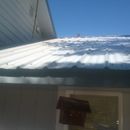Metal Roof Fasteners backing out
Hi Martin Holladay.
I was reading Fine Homebuilding March 2015 and found the article about through fastened metal roofing.
A friend of mine was asking about screws backing out of his roof and I was curious about your opinion about the cause and the fix.
His house is in an area that receives 1-3 feet of snow per winter. Snow usually stays for several weeks.
The metal roof has screws that have backed out.
I was thinking the snow and ice may snag against the screw during melt and movement over several seasons, working the screw out of the roof and structure.
See attached picture.
What would you suggest to prevent this from happening?
The fasteners are a screw type with integral sealing washers and a 5/16 inch hex head.
Is there a clutch head style available with a lower profile to prevent ice and snow from working against the head as melting and re-freezing occurs?
I would appreciate some feedback as to the right approach to fix his roof and fasteners, keeping them from backing out.
Thanks,
Franklin French
Auburn, Washington
[email protected]
GBA Detail Library
A collection of one thousand construction details organized by climate and house part










Replies
Franklin, The four most common causes of exposed fasteners backing out are:
- Incorrect initial installation. Overdriven screws damage the fibres in either the wood or sheet substrate reducing holding power.
- Ice dams can, as you say, put pressure on the heads.
- Too few fasteners combined with light gauge roofing can allow wind to create repeated movement in the panels slowly working them loose.
- Moisture in the furring or plywood reduces its holding capacity.
The best solution, but for a variety of reasons not the most palatable, is to replace the roof with a concealed fastener snap-lock roof. Barring that, and given that the substrate is in good shape, I'd replace all the gasketted fasteners with ones of a much larger diameter.
Excellent answer, Malcolm.
I've also heard that the expansion and contraction of through fastened steel due to temperature changes can work the screws loose. This is exacerbated when the substrate is thin plywood or osb. Solid wood strapping or purlins are the preferred substrate.